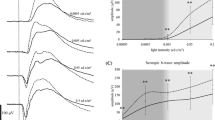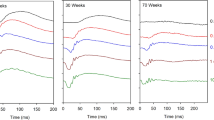Abstract
The development of the electroretinogram in the rabbit has been said to proceed with first the a-wave, then the b-wave and last the oscillatory potentials. The aim of our study was to reexamine this claim with special attention to the oscillatory potentials. Albino rabbits from the same litter were studied at weekly intervals for five weeks from the first week of life. A Grass photostimulator was used in light and dark adaptation and 50 amplified responses were averaged. Both 1–1000 Hz (electroretinogram) and 100–1000 Hz (oscillatory potential) band-widths were recorded simultaneously. The a-wave was the earliest signal to appear, at the second week of life. A rapid growth of the b-wave and oscillatory potentials was then noted between the second and third weeks, followed by a slower change. They evolved at the same rate, each with an increase in amplitude and decrease in peak time. The change in form of the b-wave was consistent with the sequential formation of each potential as the rabbit matured. The finding of simultaneous development of the b-wave and oscillatory potentials in the aging neonatal rabbit is contrary to previous reports.
Similar content being viewed by others
References
Cobb WA, Morton HB. A new component of the human electroretinogram. J Physiol 1954; 123: 37–7.
Hamasaki DI, Maguire GW. Physiological development of the kitten's retina: an electroretinographic study. Vision Res 1985; 25: 1537–43.
Sanada T. Study on the electroretinogram on suckling rabbits: Report III. Studies on oscillatory small waves due to stimulation of white light. Nippon Ganka Gakkai Zasshi 1964; 68: 1741–6.
Sanada T. Study on the electroretinogram on suckling rabbits: Report IV. Observation of oscillatory wavelets produced by monochromatic stimulation. Nippon Ganka Gakkai Zasshi 1964; 68: 1859–70.
Lachapelle P, Little JM, Polomeno RC. The photopic electroretinogram in congenital stationary night blindness with myopia. Invest Ophthalmol Vis Sci 1983; 24: 442–50.
Lachapelle P, Molotchnikoff S. Components of the electroretinogram. Doc Ophthalmol 1986; 63: 337–48.
Reuter JH. The development of the electroretinogram in normal and light deprived rabbits. Pflügers Arch 1976; 363: 7–13.
Gum GG, Gelatt KN, Samuelson DA. Maturation of the retina of the canine neonate as determined by electroretinography and histology. Am J Vet Res 1984; 45: 1166–71.
Heynen H, van Norren D. Origin of the electroretinogram in the intact macaque eye: II. Current source density analysis. Vision Res 1985; 25: 709–15.
Wachtmeister L, Dowling JE. The oscillatory potentials of the mudpuppy retina. Invest Ophthalmol Vis Sci 1978; 17: 1176–88.
Miller RF, Dowling JE. Intracellular response of the muller (glial) cells of the mudpuppy retina. Their relation to the b-wave of the electroretinogram. J Neurophysiol 1970; 33: 323–41.
Gutierrez C, Spiguel RD. Oscillatory potentials of the cat retina: Effects of adrenergic drugs. Life Sci 1973; 13: 991–9.
Pacheo P, Muzquiz L. Two retinal processes displayed in the cat electroretinogram. Vis Res 1982; 22: 1525–32.
Lachapelle P. Impact of the recording bandwidth on the electroretinogram. Can J Ophthalmol 1985; 20: 211–5.
Lachapelle P. Oscillations on the electroretinogram: a synthetic approach. Can J Ophthalmol 1985; 20: 216–9.
Lachapelle P, Molotchnikoff S. A composite nature for the photopic b-wave of the human electroretinogram as evidence by the use of the 60 Hz notch filter. Can J Ophthalmol 1986; 21: 19–22.
Author information
Authors and Affiliations
Rights and permissions
About this article
Cite this article
Gorfinkel, J., Lachapelle, P. & Molotchnikoff, S. Maturation of the electroretinogram of the neonatal rabbit. Doc Ophthalmol 69, 237–245 (1988). https://doi.org/10.1007/BF00154404
Issue Date:
DOI: https://doi.org/10.1007/BF00154404




